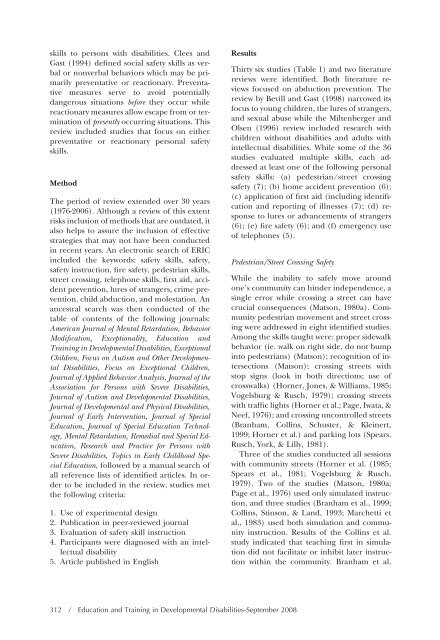Download the Journal (PDF) - Division on Autism and ...
Download the Journal (PDF) - Division on Autism and ...
Download the Journal (PDF) - Division on Autism and ...
You also want an ePaper? Increase the reach of your titles
YUMPU automatically turns print PDFs into web optimized ePapers that Google loves.
skills to pers<strong>on</strong>s with disabilities. Clees <strong>and</strong><br />
Gast (1994) defined social safety skills as verbal<br />
or n<strong>on</strong>verbal behaviors which may be primarily<br />
preventative or reacti<strong>on</strong>ary. Preventative<br />
measures serve to avoid potentially<br />
dangerous situati<strong>on</strong>s before <str<strong>on</strong>g>the</str<strong>on</strong>g>y occur while<br />
reacti<strong>on</strong>ary measures allow escape from or terminati<strong>on</strong><br />
of presently occurring situati<strong>on</strong>s. This<br />
review included studies that focus <strong>on</strong> ei<str<strong>on</strong>g>the</str<strong>on</strong>g>r<br />
preventative or reacti<strong>on</strong>ary pers<strong>on</strong>al safety<br />
skills.<br />
Method<br />
The period of review extended over 30 years<br />
(1976-2006). Although a review of this extent<br />
risks inclusi<strong>on</strong> of methods that are outdated, it<br />
also helps to assure <str<strong>on</strong>g>the</str<strong>on</strong>g> inclusi<strong>on</strong> of effective<br />
strategies that may not have been c<strong>on</strong>ducted<br />
in recent years. An electr<strong>on</strong>ic search of ERIC<br />
included <str<strong>on</strong>g>the</str<strong>on</strong>g> keywords: safety skills, safety,<br />
safety instructi<strong>on</strong>, fire safety, pedestrian skills,<br />
street crossing, teleph<strong>on</strong>e skills, first aid, accident<br />
preventi<strong>on</strong>, lures of strangers, crime preventi<strong>on</strong>,<br />
child abducti<strong>on</strong>, <strong>and</strong> molestati<strong>on</strong>. An<br />
ancestral search was <str<strong>on</strong>g>the</str<strong>on</strong>g>n c<strong>on</strong>ducted of <str<strong>on</strong>g>the</str<strong>on</strong>g><br />
table of c<strong>on</strong>tents of <str<strong>on</strong>g>the</str<strong>on</strong>g> following journals:<br />
American <str<strong>on</strong>g>Journal</str<strong>on</strong>g> of Mental Retardati<strong>on</strong>, Behavior<br />
Modificati<strong>on</strong>, Excepti<strong>on</strong>ality, Educati<strong>on</strong> <strong>and</strong><br />
Training in Developmental Disabilities, Excepti<strong>on</strong>al<br />
Children, Focus <strong>on</strong> <strong>Autism</strong> <strong>and</strong> O<str<strong>on</strong>g>the</str<strong>on</strong>g>r Developmental<br />
Disabilities, Focus <strong>on</strong> Excepti<strong>on</strong>al Children,<br />
<str<strong>on</strong>g>Journal</str<strong>on</strong>g> of Applied Behavior Analysis, <str<strong>on</strong>g>Journal</str<strong>on</strong>g> of <str<strong>on</strong>g>the</str<strong>on</strong>g><br />
Associati<strong>on</strong> for Pers<strong>on</strong>s with Severe Disabilities,<br />
<str<strong>on</strong>g>Journal</str<strong>on</strong>g> of <strong>Autism</strong> <strong>and</strong> Developmental Disabilities,<br />
<str<strong>on</strong>g>Journal</str<strong>on</strong>g> of Developmental <strong>and</strong> Physical Disabilities,<br />
<str<strong>on</strong>g>Journal</str<strong>on</strong>g> of Early Interventi<strong>on</strong>, <str<strong>on</strong>g>Journal</str<strong>on</strong>g> of Special<br />
Educati<strong>on</strong>, <str<strong>on</strong>g>Journal</str<strong>on</strong>g> of Special Educati<strong>on</strong> Technology,<br />
Mental Retardati<strong>on</strong>, Remedial <strong>and</strong> Special Educati<strong>on</strong>,<br />
Research <strong>and</strong> Practice for Pers<strong>on</strong>s with<br />
Severe Disabilities, Topics in Early Childhood Special<br />
Educati<strong>on</strong>, followed by a manual search of<br />
all reference lists of identified articles. In order<br />
to be included in <str<strong>on</strong>g>the</str<strong>on</strong>g> review, studies met<br />
<str<strong>on</strong>g>the</str<strong>on</strong>g> following criteria:<br />
1. Use of experimental design<br />
2. Publicati<strong>on</strong> in peer-reviewed journal<br />
3. Evaluati<strong>on</strong> of safety skill instructi<strong>on</strong><br />
4. Participants were diagnosed with an intellectual<br />
disability<br />
5. Article published in English<br />
Results<br />
Thirty six studies (Table 1) <strong>and</strong> two literature<br />
reviews were identified. Both literature reviews<br />
focused <strong>on</strong> abducti<strong>on</strong> preventi<strong>on</strong>. The<br />
review by Bevill <strong>and</strong> Gast (1998) narrowed its<br />
focus to young children, <str<strong>on</strong>g>the</str<strong>on</strong>g> lures of strangers,<br />
<strong>and</strong> sexual abuse while <str<strong>on</strong>g>the</str<strong>on</strong>g> Miltenberger <strong>and</strong><br />
Olsen (1996) review included research with<br />
children without disabilities <strong>and</strong> adults with<br />
intellectual disabilities. While some of <str<strong>on</strong>g>the</str<strong>on</strong>g> 36<br />
studies evaluated multiple skills, each addressed<br />
at least <strong>on</strong>e of <str<strong>on</strong>g>the</str<strong>on</strong>g> following pers<strong>on</strong>al<br />
safety skills: (a) pedestrian/street crossing<br />
safety (7); (b) home accident preventi<strong>on</strong> (6);<br />
(c) applicati<strong>on</strong> of first aid (including identificati<strong>on</strong><br />
<strong>and</strong> reporting of illnesses (7); (d) resp<strong>on</strong>se<br />
to lures or advancements of strangers<br />
(6); (e) fire safety (6); <strong>and</strong> (f) emergency use<br />
of teleph<strong>on</strong>es (5).<br />
Pedestrian/Street Crossing Safety<br />
312 / Educati<strong>on</strong> <strong>and</strong> Training in Developmental Disabilities-September 2008<br />
While <str<strong>on</strong>g>the</str<strong>on</strong>g> inability to safely move around<br />
<strong>on</strong>e’s community can hinder independence, a<br />
single error while crossing a street can have<br />
crucial c<strong>on</strong>sequences (Mats<strong>on</strong>, 1980a). Community<br />
pedestrian movement <strong>and</strong> street crossing<br />
were addressed in eight identified studies.<br />
Am<strong>on</strong>g <str<strong>on</strong>g>the</str<strong>on</strong>g> skills taught were: proper sidewalk<br />
behavior (ie. walk <strong>on</strong> right side, do not bump<br />
into pedestrians) (Mats<strong>on</strong>); recogniti<strong>on</strong> of intersecti<strong>on</strong>s<br />
(Mats<strong>on</strong>); crossing streets with<br />
stop signs (look in both directi<strong>on</strong>s; use of<br />
crosswalks) (Horner, J<strong>on</strong>es, & Williams, 1985;<br />
Vogelsburg & Rusch, 1979); crossing streets<br />
with traffic lights (Horner et al.; Page, Iwata, &<br />
Neef, 1976); <strong>and</strong> crossing unc<strong>on</strong>trolled streets<br />
(Branham, Collins, Schuster, & Kleinert,<br />
1999; Horner et al.) <strong>and</strong> parking lots (Spears,<br />
Rusch, York, & Lilly, 1981).<br />
Three of <str<strong>on</strong>g>the</str<strong>on</strong>g> studies c<strong>on</strong>ducted all sessi<strong>on</strong>s<br />
with community streets (Horner et al. (1985;<br />
Spears et al., 1981; Vogelsburg & Rusch,<br />
1979). Two of <str<strong>on</strong>g>the</str<strong>on</strong>g> studies (Mats<strong>on</strong>, 1980a;<br />
Page et al., 1976) used <strong>on</strong>ly simulated instructi<strong>on</strong>,<br />
<strong>and</strong> three studies (Branham et al., 1999;<br />
Collins, Stins<strong>on</strong>, & L<strong>and</strong>, 1993; Marchetti et<br />
al., 1983) used both simulati<strong>on</strong> <strong>and</strong> community<br />
instructi<strong>on</strong>. Results of <str<strong>on</strong>g>the</str<strong>on</strong>g> Collins et al.<br />
study indicated that teaching first in simulati<strong>on</strong><br />
did not facilitate or inhibit later instructi<strong>on</strong><br />
within <str<strong>on</strong>g>the</str<strong>on</strong>g> community. Branham et al.
















